The International Institute for Species Exploration has announced their top 10 new species described in 2009.
Making the cut are a minnow with fangs, golden orb spider and carnivorous sponge. The 2009 top 10 new species also include a deep-sea worm that, when threatened, releases green luminescent "bombs," a sea slug that eats insects, a flat-faced frogfish with an unusual psychedelic pattern, and a two-inch mushroom that was the subject of a "Bluff the Listener" segment on the National Public Radio quiz show "Wait, Wait Don't Tell Me."
Rounding out the top 10 list are a banded knifefish, a charismatic plant that produces insect-trapping pitchers the size of an American football, and an edible yam that uncharacteristically sports multiple lobes instead of just one.
The top 10 new species come from around the world, including Africa, Indonesia, Madagascar, Myanmar, New Zealand, the Philippines, Thailand, the United States and Uruguay.
An international committee of experts, chaired by Janine N. Caira of the University of Connecticut, selected the top 10 new species for the 2010 list. Mary Liz Jameson of Wichita State University served as vice chair. Nominations were invited through the species.asu.edu website and also generated by institute staff and committee members.
The Winners
Among this year's top 10 picks is a minnow with fangs – Danionella dracula – found in a stream at Sha Du Zup between Mogaung and Tanai in Kachin State, Myanmar. The males of the species have canine-like fangs for sparring with other males. This is the first record of oral teeth-like structures being found in the Cyprinidae, the largest family of freshwater fishes.
 Live male and scanning electron micrograph of male. Images courtesy of Ralf Britz, The Natural History Museum
Live male and scanning electron micrograph of male. Images courtesy of Ralf Britz, The Natural History Museum
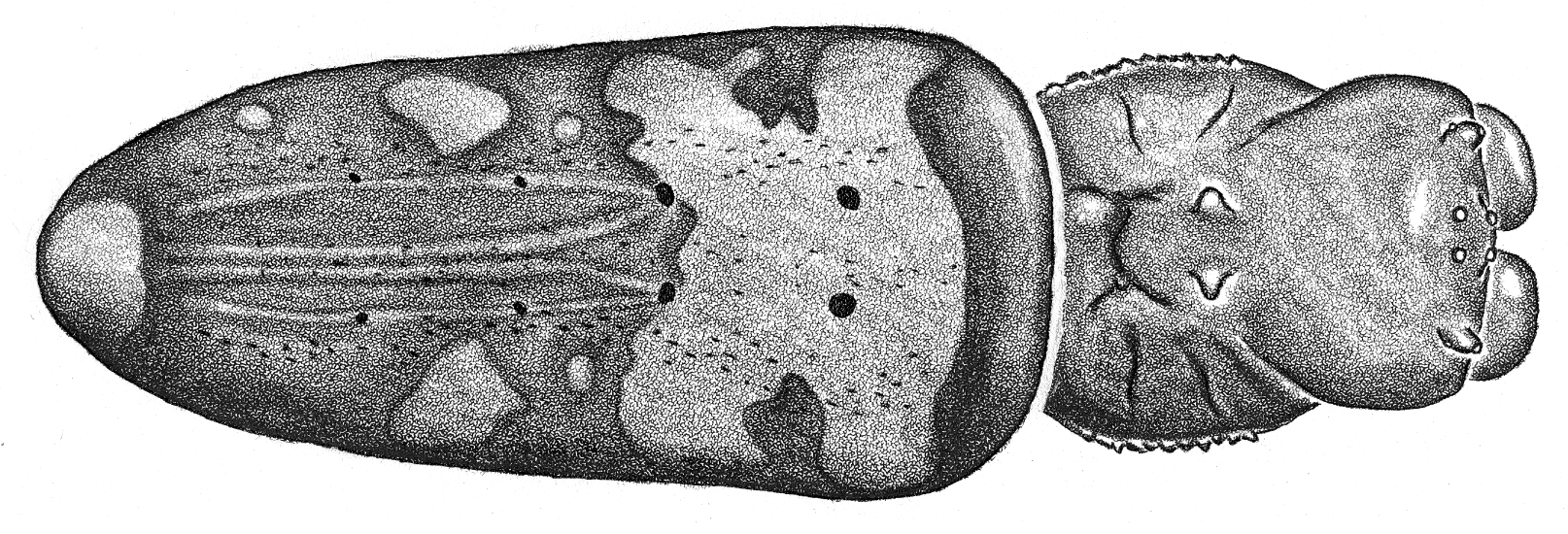 Habitus of female Nephila komaci. Image courtesy of Matjaž Kuntner
Habitus of female Nephila komaci. Image courtesy of Matjaž Kuntner
In the category of "killer sponge" is a carnivorous deep-sea sponge – Chondrocladia (Meliiderma) turbiformis – that displays a special type of spicule for which the new term "trochirhabd" has been coined.
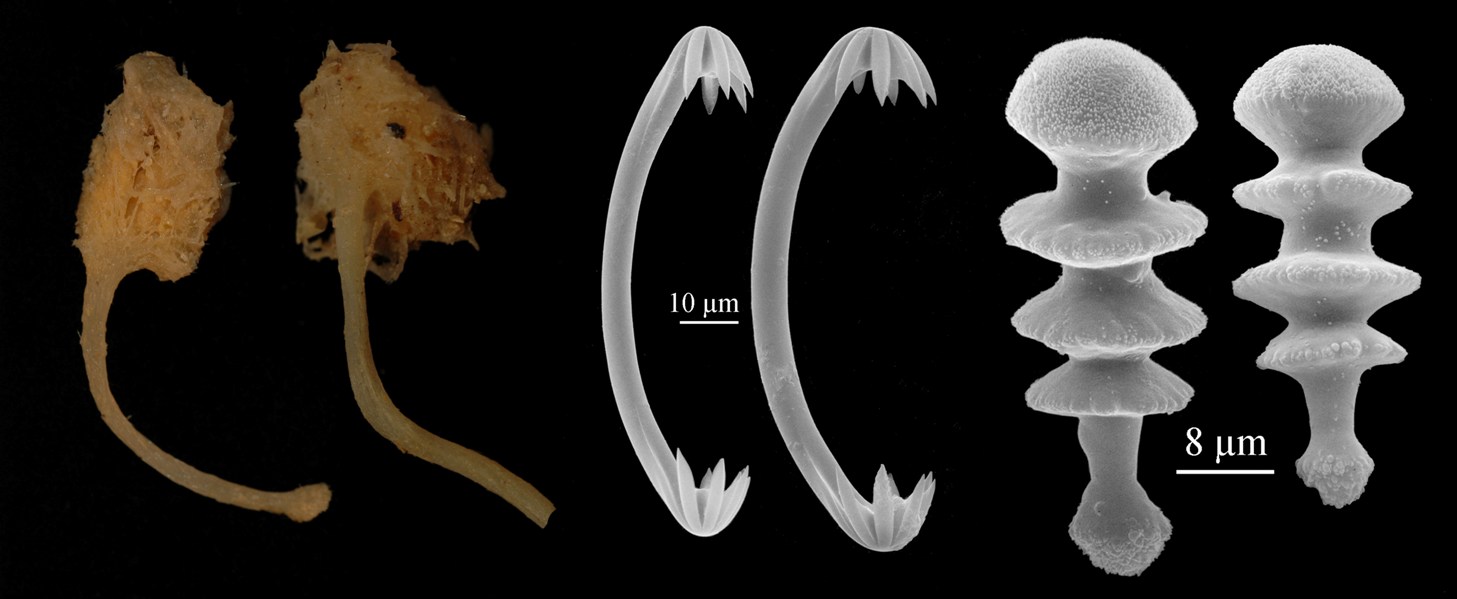 Carnivorous sponge Chondrocladia (Meliiderma) turbiformis, holotype, a paratype, isochelae and trochirhabd spicules. Image courtesy of Jean Vacelet
Carnivorous sponge Chondrocladia (Meliiderma) turbiformis, holotype, a paratype, isochelae and trochirhabd spicules. Image courtesy of Jean Vacelet
Another deep-sea selection for this year's list is Swima bombiviridis, a worm discovered off the central coast of California that when threatened releases "bombs" that illuminate for several seconds with green bioluminescence.
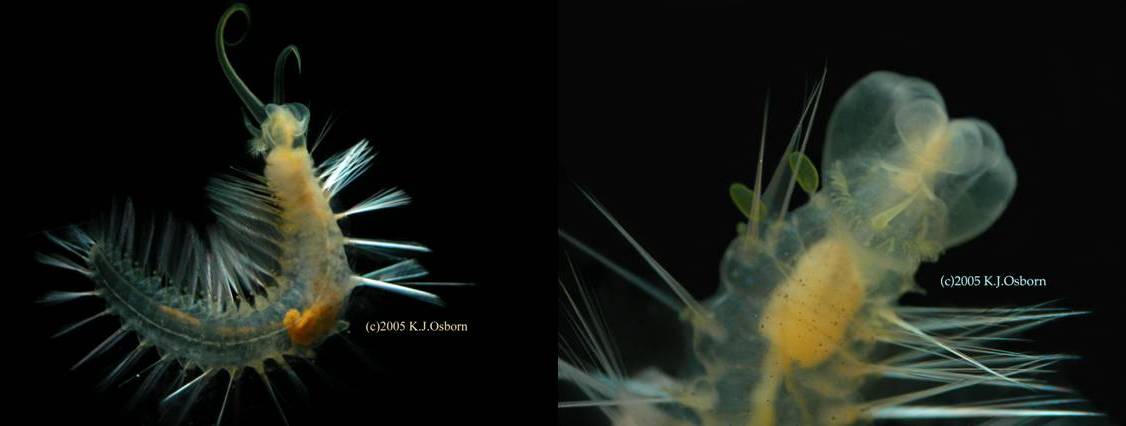 Swima bombiviridis, second image shows the "bombs". © 2005 K. J. Osborn
Swima bombiviridis, second image shows the "bombs". © 2005 K. J. Osborn
From Pak Phanang Bay in the Gulf of Thailand is a sea slug – Aiteng ater – that eats bugs, which is unusual since nearly all sacoglossans eat algae and a few specialize in gastropod eggs. Its discovery has resulted in a new family, Aitengidae.
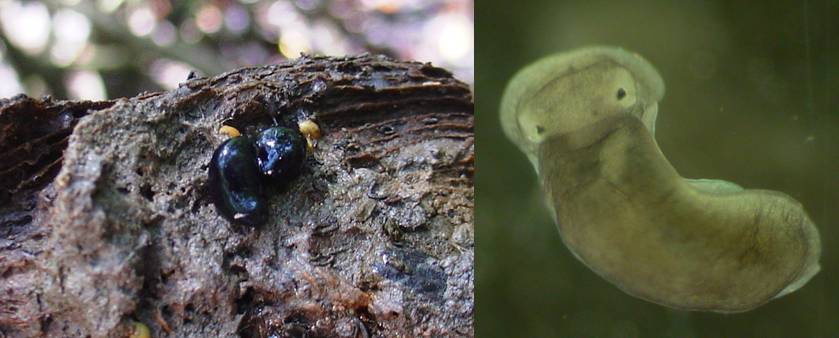 The black objects are two adult specimens in a mangrove forest at the type locality; the second is an immature specimen. Images courtesy of Cornelis Swennen.
The black objects are two adult specimens in a mangrove forest at the type locality; the second is an immature specimen. Images courtesy of Cornelis Swennen.
Several fish made this year's top 10 new species list, including a frogfish – Histiophryne psychedelica – that has an unusual psychedelic pattern and is unique among frogfishes for its flat face.
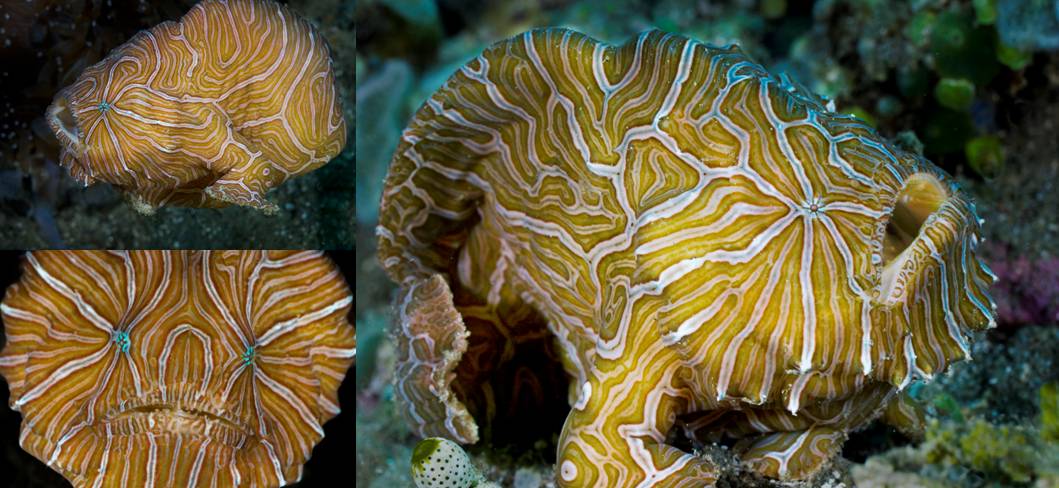 Top left image of frogfish jetting and the right image is it walking with its fins) Histiophryne psychedelica © David Hall/seaphotos.com
Top left image of frogfish jetting and the right image is it walking with its fins) Histiophryne psychedelica © David Hall/seaphotos.com
A two-inch mushroom – Phallus drewesii – was named, with permission, in honor of Robert C. Drewes at the California Academy of Sciences. Drewes, who initiated extensive multi-organism biodiversity studies on the island of São Tomé, Africa, where this news species of stinkhorn fungus was found, dedicated more than 30 years of his life to research in Africa, according to the scientists who made the discovery.
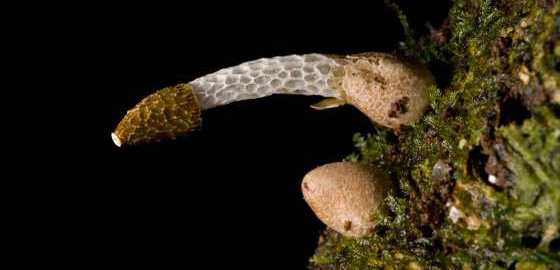 Phallus drewesii. Image courtesy of Brian A. Perry, University of Hawai'i at Hilo
Phallus drewesii. Image courtesy of Brian A. Perry, University of Hawai'i at Hilo
An electric fish – Gymnotus omarorum – goes by the common name Omars' banded knifefish. The species was named to honor Omar Macadar and Omar Trujillo-Cenoz, pioneers in the anatomical and physiological study of electrogenesis in Gymnotus.
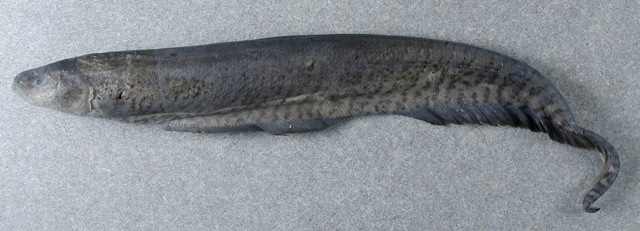 Gymnotus omarorum. Image courtesy of James Albert
Gymnotus omarorum. Image courtesy of James Albert
From the plant kingdom is a charismatic plant species – Nepenthes attenboroughii – that produces one of the largest pitchers known, each the size of an American football. It also is carnivorous, feeding on insects trapped by the fluid contained in the pitchers.
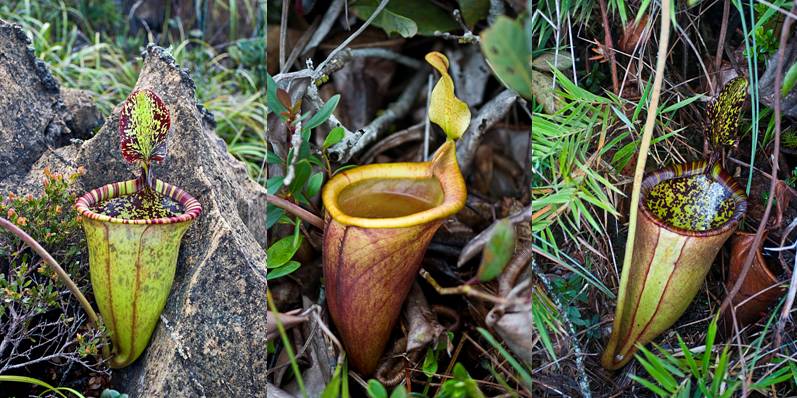 The spectacular traps of the tropical pitcher plant, Nepenthes attenboroughii. Images courtesy of Alastair S. Robinson
The spectacular traps of the tropical pitcher plant, Nepenthes attenboroughii. Images courtesy of Alastair S. Robinson
Rounding out the top 10 picks is another from the plant kingdom, an "udderly weird yam" – Dioscorea orangeana – that was found in Madagascar. Its tuber morphology is uncharacteristic of edible Malagasy yams exhibiting several digitate lobes, instead of just one.
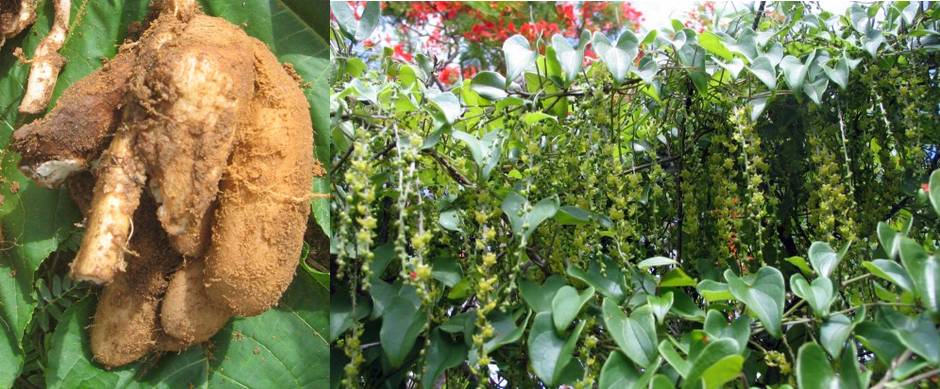 Dioscorea orangeana. Images courtesy of Claude Marcel Hladik
Dioscorea orangeana. Images courtesy of Claude Marcel Hladik
"Annually, an international committee of taxon experts, helps us draw attention to biodiversity, the field of taxonomy, and the importance of natural history museums and botanical gardens, in a fun-filled way by making the selection of the top 10 new species from the thousands described in the previous calendar year," says Quentin Wheeler, director of the International Institute for Species Exploration at Arizona State University and an entomologist in the School of Life Sciences.
Wheeler advocates a new generation of cyber-tools and Web accessible resources that will vastly accelerate the rate at which humans are able to discover and describe species.
"Most people do not realize just how incomplete our knowledge of Earth's species is or the steady rate at which taxonomists are exploring that diversity. We are surrounded by such an exuberance of species diversity that we too often take it for granted."
Issuing an SOS
The taxonomists also are issuing an SOS – State of Observed Species – report on human knowledge of Earth's species. In it, they report that 18,225 living species new to science were described in 2008, the most recent year for which complete data are available. The SOS report trumpets the latest discoveries of previously unknown plants, animals, microbes, algae and fungi. It also notes 2,140 fossil species described as new in 2008.
The SOS report was compiled by ASU's International Institute for Species Exploration in partnership with the International Plant Names Index, Zoological Record published by Thomson Reuters, International Journal of Systematic and Evolutionary Microbiology, AlgaeBase, MycoBank and World Register of Marine Species.
The SOS report summarizes the number of major plant and animal species newly described for the most recent year of complete data, which is 2008. The majority of the 18,225 species described (named) in 2008 were insects (48.25 percent), vascular plants (11.41 percent) and fungi (7.37 percent) with arachnids coming in a close fourth (7.24 percent). The SOS report also includes data for prokaryotes (bacteria and Archaea) in addition to protists.
The State of Observed Species report and list of top 10 new species issued annually by ASU's International Institute for Species Exploration is part of its public awareness campaign to shine attention on biodiversity and the field of taxonomy. Previous top 10 lists and SOS reports are online at http://species.asu.edu.





Comments